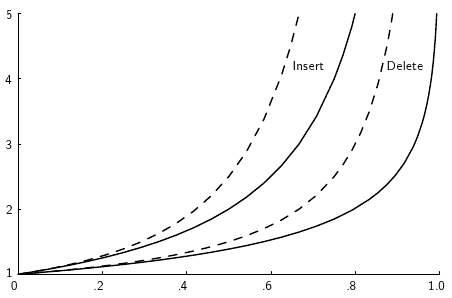Linear Probing
- Problem: primary clustering - collisions tend to cause clusters of occupied buckets.
- The larger the cluster gets, the higher the probabilility that it will grow.
Impact of Load Factor on Cost

Load factor is on the x-axis, expected number of buckets accessed on the y-axis.
(From OpenDSA Data Structures and Algorithms book)
Solution #1: Quadratic Probing
- Probe function: \(p(K, i) = c_1 \times i + c_2 \times i^2\)
- Bucket to access: \(h(K) + p(K, i)\), where:
- \(K\) - original key
- \(h(K)\) - result of hashing the key
- \(p(K, i)\) - offset from the original hash location to check after \(i\) collisions
- For example, assuming \(c_1 = 1, c_2 = 1\):
- After one collision: \(p(K, 1) = 1 + 1 = 2\)
- After two collisions: \(p(K, 2) = 2 + 4 = 6\)
- After one collision: \(p(K, 3) = 3 + 9 = 12\)
- After one collision: \(p(K, 4) = 4 + 16 = 20\)
- Problem:
- Secondary Clustering: Keys that hash to the same bucket will follow the same probe sequence.
Solution #2: Double Hashing
- Probe function: \(p(K, i) = h_2(K) \times i\)
- Example with \(h_2(K) = 1 + K \% 7\)
- After one collision for \(K=11\): \(p(K, 1) = 5 \times 1 = 5\)
- After two collisions for \(K=11\): \(p(K, 2) = 5 \times 2 = 10\)
- After two collisions for \(K=11\): \(p(K, 3) = 5 \times 3 = 15\)
- Different keys follow different probe sequences, so this is resistant to both primary and secondary clustering.
Problems/Challenges with Hashing
- No ordered iteration.
- Iteration can be relatively inefficient when it involves iterating past empty buckets.
- Good hashing can lead to poor cache performance.
- Worst case performance is very bad.
What Gets used In The Wild?
C#/.net Dictionary
- Prime-number-sized tables
- Collision Resolution: Separate Chaining (in an array)
Max load factor: 1.0
Python 2
- Closed hashing
- Power-of-two table sizes
- Hash function: grab lower order bits (no effort to avoid collisions)
Calculating mask:
Finding index:
- Collision resolution: fancy double hashing
Original hash \(j\) is modified according to:
perturbis initialized to the original hash, then bit-shifted after every collision.Default load factor .66
Implementation in: Python-2.7.2/Objects/dictobject.c. Source can be downloaded from www.python.org.
Python 3.6+
Update in Python 3:
the dictionary:
d = {'timmy': 'red', 'barry': 'green', 'guido': 'blue'}
is currently stored as:
entries = [['--', '--', '--'],
[-8522787127447073495, 'barry', 'green'],
['--', '--', '--'],
['--', '--', '--'],
['--', '--', '--'],
[-9092791511155847987, 'timmy', 'red'],
['--', '--', '--'],
[-6480567542315338377, 'guido', 'blue']]
Instead, the data should be organized as follows:
indices = [None, 1, None, None, None, 0, None, 2]
entries = [[-9092791511155847987, 'timmy', 'red'],
[-8522787127447073495, 'barry', 'green'],
[-6480567542315338377, 'guido', 'blue']]
Only the data layout needs to change. The hash table
algorithms would stay the same.descripion: https://mail.python.org/pipermail/python-dev/2012-December/123028.html
source: https://github.com/python/cpython/blob/main/Objects/dictobject.c
Ruby
- Originally:
- Prime-number-sized tables
- Collision resolution: chaining
- Max load factor: 5
- More recently:
- Very similar to the Python3 approach
Original source: https://github.com/ruby/ruby/blob/ruby_2_3/st.c Updated source: https://github.com/ruby/ruby/blob/ruby_3_0/st.c
Java 7 (We’ve seen…)
- Power-of-two table sizes
- Hash Function: bit scrambling, then use lower-order bits.
- Collision resolution: Chaining
- Default load factor: .75
static int hash(int h) {
// This function ensures that hashCodes that differ only by
// constant multiples at each bit position have a bounded
// number of collisions (approximately 8 at default load factor).
h ^= (h >>> 20) ^ (h >>> 12);
return h ^ (h >>> 7) ^ (h >>> 4);
}
/**
* Returns index for hash code h.
*/
static int indexFor(int h, int length) {
return h & (length-1);
}Java 8+
- Power-of-two table sizes
- Hash Function: a little bit shifting, then use lower-order bits.
- Collision resolution: Chaining, CONVERT TO TREES IF THE CHAIN GETS LONGER THAN 8!
- Default load factor: .75
static final int hash(Object key) {
int h;
return (key == null) ? 0 : (h = key.hashCode()) ^ (h >>> 16);
}Java 16 Source: https://github.com/openjdk/jdk/blob/jdk-16+36/src/java.base/share/classes/java/util/HashMap.java